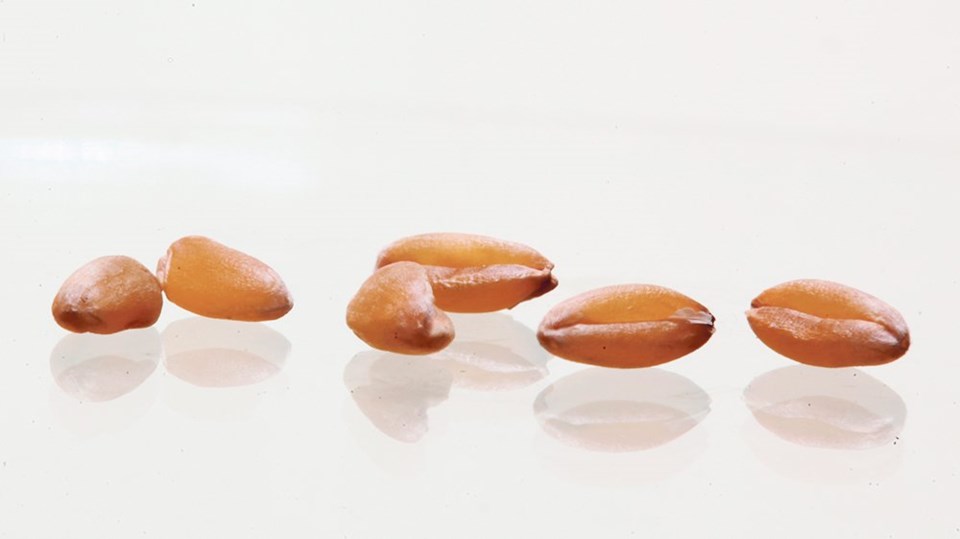First the good news.
Despite widespread drought and extreme heat last summer, the quality of seed for cereal crops appears to be quite good, according to seed analysts.
As of early December, cereal seed samples submitted for analysis were showing good germination and vigour scores in Alberta, said Rachael Melenka, client success manager with 20/20 Seed Labs in Nisku, Alta.
In Saskatchewan, cereal seed quality is also good, although germination rates in barley are slightly lower than normal, added Jason Danielson, business manager with Discovery Seed Labs in Melville.
Thousand kernel weights are below average for some wheat and durum grown in Alberta, Melenka added, but overall, cereal seed quality and performance does not appear to have been negatively affected.
“Challenges that come out of (those hot, dry conditions can include) low germination and vigour, as well as we’ll sometimes see more seed dormancy,” Melenka said during a Farm Forum event held Dec. 8.
“So that’s kind of what we were predicting heading into this season, before samples started rolling in.… But there is good news for seed quality. For cereals, we’re actually seeing quite good germination and vigour across all (cereal) crop kinds for Alberta.”
According to seed quality data from 20/20 Seed Labs in November, average germination rates for Alberta cereal seed samples ranged from a low of 91.3 percent in triticale up to a high of 96.5 percent in wheat.
Alberta’s average germination rates for oats (92.5 percent), barley (94.2 percent), durum (95 percent) and rye (95.8 percent) also exceeded expectations, based on November 2021 test results.
Ideally, growers should seek out seed with a minimum germination score of 85 percent.
Germination below 85 percent can still produce a crop, but the 85 percent threshold is typically where growers should consider looking elsewhere for higher seed quality.
Vigour scores can be equally important, and once again, there was good news in Alberta based on November test results, said Melenka.
Seed vigour scores in samples analyzed by 20/20 Seed Labs ranged from a low of 84.5 percent in triticale to a high of 94 percent in rye.
Average vigour scores in wheat, barley, durum and oats were 92.3 percent, 87.8 percent, 91.2 percent and 87.1 percent respectively, based on November 2021 lab results.
Seed vigour is an important consideration, particularly if cereal crops are sown early into cool soils.
Some seed mortality can be expected If vigour is high and ungerminated seeds sit in the soil for a week.
However, mortality rates rise if seeds sit in the cold soil for much more than a week. The seedlings that emerge will be weaker and more prone to stress factors, including disease.
Good seed vigour, combined with seeding dates that are not aggressively early, can limit seed mortality and produce a crop that competes well.
The bad news mostly concerns pulse crops.
Mechanical damage in pulses — most notably field peas and fababeans — was unusually high in Alberta last year, based on seed tests conducted last month, said Melenka.
“Over 50 percent of (pulse) samples coming into the lab were affected by mechanical damage,” she said.
“Definitely, field peas and fababeans are crops to watch over the winter storage (period).”
Generally speaking, pulse crops are more susceptible to mechanical damage than any other crop type.
This is particularly true when harvest conditions are hot and dry and seed moisture content is low.
The hot, dry harvest conditions that prevailed last year resulted in a higher number of splits and cracked seed coats.
The percentage of damaged kernels can be expected to rise even more during cleaning, handling and transportation.
“Any type of split or crack (on the seed coat) is going to allow water to imbibe a bit more aggressively and might damage those growing parts of the seed,” Melenka said.
To limit seed damage, growers should avoid moving it unnecessarily, use slower auger speeds and eliminate situations where seeds are dropped a long distance into the bin, tank or truck box.
Growers should also consider retesting their pulse seed after winter storage to ensure that seed viability hasn’t been negatively affected during winter storage.
Danielson said mechanical damage in pea samples is a cause for concern.
“The biggest red flag that we’re seeing right now is in peas, related to mechanical damage and likely caused by the dry harvest,” he said.
“Original germs in some peas aren’t looking good and some guys that have already got their second germs are seeing that it’s already dropping a bit, which is not a good sign.”
Mechanical damage is also evident in lentils but should not cause any major problems.
Average germination rates in submitted barley samples and flax are also lower than normal, based on lab tests conducted as of early December.
Disease levels in seed are generally low based on the hot, dry conditions last year, but there were still hot spots where fusarium graminearum levels were on the high side in wheat, durum and barley.
Danielson said growers might be able to compensate for low pea germination by adjusting their seeding rates. When pea germination falls to the low 80s or less, the preferable course of action is to seek out a better seed source, he added.
Melenka said thousand kernel weights in cereals warrant close attention this year.
It is likely to be below average for much of the wheat and durum seed produced this year, meaning seeding rates could potentially be lowered provided that germination and vigour scores are still in an acceptable range.
In some cases, stretching seed supplies could be an economically beneficial strategy.
“For thousand kernel weights, we’re definitely recommending getting this tested because it will be an economic benefit to adjust your seeding rates before spring,” she said.

